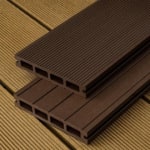 The “Biocomposites Conference Cologne (BCC)” will take place on 6 and 7 December 2017 in Cologne, Germany. This year’s conference and exhibition will be the largest industry meeting on biocomposites worldwide. More than 250 participants and 30 exhibitors are expected.
The “Biocomposites Conference Cologne (BCC)” will take place on 6 and 7 December 2017 in Cologne, Germany. This year’s conference and exhibition will be the largest industry meeting on biocomposites worldwide. More than 250 participants and 30 exhibitors are expected.What are biocomposites?
Biocomposites is an umbrella term for composites made completely, or to a significant degree, from biomass: Natural and wood fibres are combined with petrochemical or bio-based polymers to achieve very good mechanical and often even light-weight properties. The most commonly used types of biocomposites are Wood-Plastic Composites (WPC) and Natural Fibre Composites (NFC).Existing markets and new opportunities
In the past, Wood-Plastic Composites (WPC) were mainly processed via extrusion technologies (decking) and Natural Fibre Composites (NFC) mainly in press moulding (automotive).For many years, research institutes and industrial labs have continuously developed WPC and NFC applications, using the materials in small series of consumer goods. Relevant volumes were only deployed in the decking market, which is still the biggest sector in the biocomposites market.
However, quite recently biocomposites have started to enter several additional markets. With the latest advances in injection moulding and 3D printing, both WPC and NFC are of high interest for a multitude of applications and fruitful new synergies are being created for new products. More and more companies specifically use wood and natural fibre plastic granulates in consumer goods such as instruments, electronic casings, furniture, tables, toys, combs or trays as well as 3D printed goods – the unique look and haptics convey high quality and value and are well received by customers. There are many opportunities for these niche materials to achieve large-scale production soon.
Benefits of biocomposite materials
Consumer products made of WPC or NFC have a different look than pure plastic products; they become noticeable, have a nice touch and reduce the use of plastic due to the wood and natural fibres or are even available completely without any oil-based materials – which improves the environmental footprint. Many of the current materials offer also special properties producers are looking for, like acoustic performance, light-weight or antibacterial properties. But the most important part: the products appeal to consumers and gain public recognition.Market growth
Signs for market growth can be found in various markets: In the furniture market, IKEA re-introduced the wood-plastic composites chair PS 2012 to its programme and offers additional new products with wood-plastic composites like picture frames. Consumer electronics offer good examples for useful products as well – a product group in which acoustic performance is an essential key to the success. In this area market leader LG has started to use the cellulose-based granulate Aqvacomp as a biocomposite material in manufacturing of loudspeakers.The biocomposites industry meets in Cologne
The wide range of successful new technologies and applications of biocomposites in consumer goods, automotive industries and construction will be presented at the Biocomposites Conference Cologne, 6-7 December 2017 in Cologne, Germany. It represents the wide spectrum of innovative applications and material choices of WPC and NFC:• Biocomposites in the automotive industry
• Injection moulding: granulates and applications
• Biocomposites in 3D printing
• Structural applications
• Wood and natural fibres and other raw materials for biocomposites
• Bio-based thermosets for biocomposites


